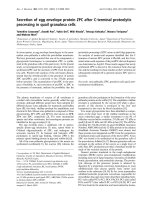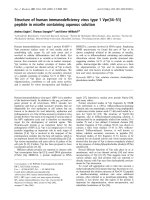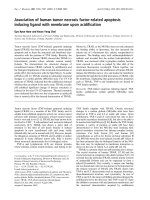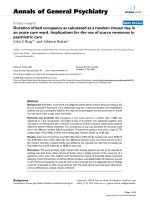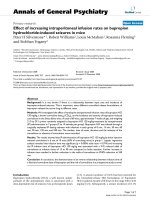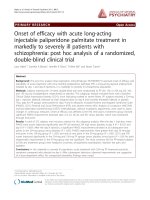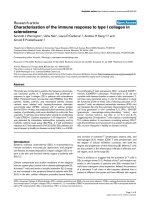Báo cáo Y học: Structure of human immunodeficiency virus type 1 Vpr(34–51) peptide in micelle containing aqueous solution pptx
Bạn đang xem bản rút gọn của tài liệu. Xem và tải ngay bản đầy đủ của tài liệu tại đây (233.36 KB, 6 trang )
Structure of human immunodeficiency virus type 1 Vpr(34–51)
peptide in micelle containing aqueous solution
Andrea Engler
1
, Thomas Stangler
2,3
and Dieter Willbold
3,4
1
Lehrstuhl fu
¨
r Biopolymere, Universita
¨
t Bayreuth, Germany;
2
Institut fu
¨
r Molekulare Biotechnologie, Jena, Germany;
3
Institut fu
¨
r
Physikalische Biologie, Heinrich-Heine-Universita
¨
t, Du
¨
sseldorf, Germany,
4
Forschungszentrum Ju
¨
lich, IBI-2, Germany
Human immunodeficiency virus type 1 protein R (HIV-1
Vpr) promotes nuclear entry of viral nucleic acids in
nondividing cells, causes G
2
cell cycle arrest and is
involved in cellular differentiation and cell death. Vpr
subcellular localization is as variable as its functions. It is
known, that consistent with its role in nuclear transport,
Vpr localizes to the nuclear envelope of human cells.
Further, a reported ion channel activity of Vpr is clearly
dependent on its localization in or at membranes. We
focused our structural studies on the secondary structure
of a peptide consisting of residues 34–51 of HIV-1 Vpr.
This part of Vpr plays an important role in Vpr
oligomerization, contributes to cell cycle arrest activity,
and is essential for virion incorporation and binding to
HHR23A, a protein involved in DNA repair. Employing
NMR spectroscopy we found this part of Vpr to be
almost completely a helical in the presence of micelles,
as well as in trifluoroethanol containing and methanol/
chloroform solvent. Our results provide structural data
suggesting residues 34–51 of Vpr to contain an amphi-
pathic, leucine-zipper-like a helix, which serves as a basis
for oligomerization of Vpr and its interactions with
cellular and viral factors involved in subcellular localiza-
tion and virion incorporation of Vpr.
Keywords: HIV-1; Vpr; solution structure; dodecylphos-
phocholine micelles; NMR.
Human immunodeficiency virus type 1 (HIV-1) is a member
of the lentivirus family. In addition to the gag, pol and env
genes present in all retroviruses, HIV-1 encodes two
regulatory and four so called ÔaccessoryÕ proteins, that are
dispensable for viral replication in cell culture but are
known to be decisive for viral infectivity, replication and
pathogenesis in vivo. One of these accessory proteins is virus
protein R (Vpr). Vpr seems to be required at various steps of
the HIV replication cycle and is therefore an interesting
target for the development of antiviral agents. This
96-amino-acid protein is an important factor for the
pathogenesis of HIV [1,2]. Vpr is an integral part of viral
particles suggesting an important role in early stages of
infection [3–6]. Vpr is involved in the transport of the
preintegration complex into the host cell nucleus, which is
an important feature for infection of nondividing cells [7,8].
Vpr arrests mammalian and yeast cells in G
2
-phase of the
cell cycle [9–12]. Further, Vpr has been proposed to have
ion-channel activity [13,14].
Different cellular proteins are reported to interact with
Vpr: transcription factor Sp1 [15], uracil DNA glycosylase
(UNG) [16], HHR23A, a protein implicated in DNA
repair [17], importin-a, nuclear pore protein Nsp1p [18],
and many others.
Former structural studies of Vpr fragments by NMR
were performed in a (30%) trifluoroethanol-containing
solution and, not surprisingly, revealed a long amphipathic
a helix-turn-a helix (amino acids 17–46) motif ended by a
turn for Vpr(1–51) [19]. The structure of Vpr(52–96)
fragment, also in trifluoroethanol-containing solution, is
characterized by an amphipathic a helix from residue 53 to
residue 78 and a less defined C-terminal domain [20].
Another fragment of Vpr, residues 50–82, was shown to
contain a helix from residues 53–81 in 50% trifluoro-
ethanol. Trifluoroethanol, however, is well known to
induce a helical secondary structures in peptides [21].
Structural studies of Vpr fragment 13–33, known to be
essential for ion channel activity and virion incorporation,
showed that this part of Vpr is almost completely a helical
in the presence of dodecylphosphocholine (dodecyl-PCho)
micelles [22].
Several different functions of Vpr take place in or at
membranes, such as ion channel activity [14] and virion
incorporation of Vpr [23–25]. This suggests most of the
various cellular and viral proteins that are reported to
directly interact with Vpr may form hydrophobic environ-
ments for Vpr interaction.
To avoid self aggregation and to take into account a
rather hydrophobic environment that may be present in vivo,
we determined the solution structure of Vpr(34–51) peptide
in micelle-containing solutions and some additional
solvents, often referred to as membrane-mimicking. Only
recently, it was shown that this region of the protein is
important for oligomerization, virion incorporation, and
subcellular localization of Vpr [26].
Correspondence to D. Willbold, Forschungszentrum Ju
¨
lich,
IBI-2, 52425 Ju
¨
lich, Germany.
Fax: + 49 2461612023, Tel.: + 49 2461612100,
E-mail:
Abbreviations: HIV, human immunodeficiency virus;
HIV-1, HIV type 1; rmsd, root mean square deviation;
SIV, simian immunodeficiency virus; Vpr, virus protein R.
(Received 13 February 2002, revised 13 May 2002,
accepted 17 May 2002)
Eur. J. Biochem. 269, 3264–3269 (2002) Ó FEBS 2002 doi:10.1046/j.1432-1033.2002.03005.x
MATERIALS AND METHODS
Peptide
The synthetic peptide CH
3
-CO-FPRIWLHNLGQHIY
ETYG-NH
2
with the amino-acid sequence of HIV-1
Vpr (34–51) was purchased as a purified product (Interac-
tiva, Ulm, Germany). N- and C-termini were modified by
an acetyl and an amide group, respectively, to remove
charges, that are not present in the full length Vpr protein
either. The peptide was more than 95% pure as judged from
reversed phase HPLC analysis. Mass spectroscopy proved
the product to have a mass of 2286 Da, close to the
theoretical value (2285.5 Da).
NMR spectroscopy
All NMR spectra were collected at 298 K on a Varian
INOVA 600 spectrometer equipped with a triple-axis pulsed
field gradient probe. Proton resonances were assigned by
standard procedures using DQF-COSY and TOCSY (80
and 90 ms mixing time) experiments. Proton–proton dis-
tance constraints were obtained from NOESY (100 and
200 ms mixing time) experiments. NOE cross peaks were
classified as strong, medium and weak and converted into
upper limit distance constraints of 2.7, 3.5 and 5.0 A
˚
,
respectively. In the spectra of Vpr(34–51) in chloroform/
methanol, a total of 10 residues showed
3
J
HNNa
scalar
couplings of less than 6.0 Hz and were therefore restrained
to adopt backbone torsion angles between )80° and )40°.
All NMR data were processed and analyzed with the
program package
NDEE
(SpinUp Inc., Dortmund,
Germany). Structure calculation was performed using
XPLOR
3.851 and a modified ab initio simulated annealing
protocol including floating assignment of prochiral groups
and a conformational database potential during all but the
last 200 cooling steps. Of the 60–97 structures resulting from
the final round of structure calculation, for each of the three
solvents those 20 structures showing the lowest overall
energies were selected for further characterization. No NOE
distance violation was larger than 0.016 nm. No dihedral
constraint was violated more than one degree in the
chloroform/methanol-derived structures. The calculated
structures were analyzed using the
PROCHECK
[27] and
PROMOTIF
[28] software.
The coordinates have been deposited in the Protein Data
Bank, Brookhaven National Laboratory, Upton, NY, with
accession codes 1KZS, 1KZV, and 1KZT for the resulting
structures obtained in trifluoroethanol/water, chloroform/
methanol, and dodecyl-PCho micelles, respectively. Chem-
ical shifts have also been deposited at the BioMagResBank,
University of Wisconsin, with accession no. 5283.
RESULTS AND DISCUSSION
Recently, a secondary structure prediction for HIV-1 Vpr
was reported [22] employing
PHD NETWORK
for secondary
structure prediction [29].
PHD NETWORK
has a reported
Table 1. Statistics of Vpr(34–51) structure calculations.
Trifluoroethanol/water CHCl
3
/methanol Dodecyl-PCho
Number of experimental distance restraints
total number of assigned NOEs 122 82 106
intraresidue (|i ) j| ¼ 0) 16 24 25
interresidue sequential (|i ) j| ¼ 1) 64 41 53
interresidue medium range (1 < |i ) j| £ 5) 42 17 28
long range (|i ) j| > 5) 0 0 0
X
-
PLOR
energies (kcalÆmol
)1
)
total 20.76 ± 1.36 20.04 ± 0.64 22.48 ± 2.32
bond 0.49 ± 0.08 0.42 ± 0.04 0.57 ± 0.14
angle 16.91 ± 0.65 16.80 ± 0.41 17.95 ± 1.29
impropers 1.95 ± 0.15 1.92 ± 0.07 2.12 ± 0.23
repel 0.60 ± 0.39 0.35 ± 0.23 0.94 ± 0.56
NOE 0.80 ± 0.51 0.55 ± 0.15 0.90 ± 0.54
RMS deviations to the mean structure (nm)
backbone (residues 34–51) 0.079 ± 0.027 0.115 ± 0.029 0.187 ± 0.048
heavy (residues 34–51) 0.145 ± 0.038 0.191 ± 0.027 0.248 ± 0.039
backbone (residues 38–50) 0.033 ± 0.018 0.033 ± 0.008 0.059 ± 0.023
heavy (residues 38–51) 0.110 ± 0.023 0.147 ± 0.019 0.117 ± 0.028
RMS deviations to experimental constraints and idealized geometry
bonds (pm) 0.12 ± 0.01 0.11 ± 0.02 0.13 ± 0.02
angles (degree) 0.44 ± 0.01 0.44 ± 0.01 0.45 ± 0.02
impropers (degree) 21.58 ± 2.68 18.48 ± 3.37 20.80 ± 4.76
NOE (pm) 1.1 ± 0.3 1.2 ± 0.2 1.3 ± 0.4
F,Y angles consistent with Ramachandran plot (%)
most favored regions 98.6 100 94.6
additionally allowed regions 1.4 0 2.9
generously allowed regions 0 0 1.4
disallowed regions 0 0 1.1
Ó FEBS 2002 Vpr(34–51) peptide structure (Eur. J. Biochem. 269) 3265
prediction accuracy of greater than 70%. As a result, three
amphipathic helices were predicted with the first helix
ranging from amino acid Asn16 to His33, the second helix
from Arg36 to Thr49 and the third from Trp54 to Ile74 [22].
This is in fairly good agreement with NMR structural work
in trifluoroethanol-containing solutions [19,20].
According to these secondary structure prediction results
we used synthetic Vpr(34–51) peptide, which comprises the
amino acids for the second putative helix, to investigate its
behavior under various solvent conditions.
For structural characterization of the Vpr(34–51) peptide
structure we recorded homonuclear one- and two-dimen-
sional NMR spectra of Vpr(34–51) in water, 100 m
M
dodecyl-PCho, chloroform/methanol (1 : 1, v/v) and tri-
fluoroethanol/water (1 : 1, v/v). Possibly due to self-aggre-
gation of the peptide, only a few broad resonances could be
detected in water under several pH and ionic conditions. This
is in agreement with the finding that residues in Vpr(34–51)
are responsible for Vpr oligomerization [26]. Evaluation of
DQF-COSY and TOCSY spectra resulted in the identifica-
tion of all spin systems in all three other solvents. All
resonances could be assigned sequence specifically according
to dNN(i,i +1),daN(i,i +1)anddbN(i,i +1)NOEs.
Interestingly, in trifluoroethanol/water two sets of reso-
nances for Phe34 to Asn41 were detected. This indicates the
presence of a minor population of Vpr(34–51) peptide
resulting from a cis configuration of the Phe34-Pro35
peptide bond as shown by a dNa(i ) 1,i)NOE,whichis
typical for a cis-aminoacyl-proline peptide bond. In each of
the chloroform/methanol and 100 m
M
dodecyl-PCho solu-
tions, however, only one set of resonances could be detected.
An overview of the distance constraints used for structure
calculations and structural statistics is shown in Table 1 and
Fig. 1. Backbone rmsd values of 0.115 nm and 0.079 nm
for methanol/chloroform and trifluoroethanol/water,
respectively, show the overall structures to be well defined.
Also, Vpr(34–51) peptide in 100 m
M
dodecyl-PCho shows a
well defined a helical region from Trp38 to Tyr50 as shown
by a backbone rmsd of 0.059 nm, whereas the rmsd value
for the entire peptide was 0.187 nm. This is probably due to
higher flexibility of the residues outside the a helix.
Dihedral F and Q angles of more than 99% of all residues
in the final converged structures in each of the solvents fall in
either the most favorable or additionally allowed regions.
Analysis with the
PROCHECK
[27] and
PROMOTIF
[28]
programs revealed regularly a helical secondary structure
for Vpr(34–51) peptide in each of the solvents studied. a helix
was deduced for residues Ile37 to Tyr50 in chloroform/
methanol, Trp38 to Tyr50 in 100 m
M
dodecyl-PCho, and
Pro35 to Tyr50 in trifluoroethanol/water. In the previously
reported structure of Vpr(1–51)in 30% trifluoroethanol (v/v)
the second helix also started at Pro35, but ended one turn
earlier at residue Ile46 [19]. Comparison of the structures
obtained in the different solution conditions elucidates good
conformity among the structures of Vpr(34–51) peptide for
residues Trp38 to Tyr50 in all three solvents (Fig. 2A).
Differences can be observed only for the N-terminal residues.
Not surprisingly, in trifluoroethanol/water solution the
a helix content was highest among all solvent conditions.
Chloroform/methanol was used previously for NMR
studies of peptides and proteins to mimic hydrophobic
environments [30,31]. Because the part of Vpr investigated
in the present study may be relevant for the reported ion
channel activity of Vpr [14], we also determined its structure
in chloroform/methanol.
The detected a helix content of Vpr(35–51) increased
from 76 to 88 and 94% in micelle-containing solution,
Fig. 1. Summary of the NOE connectivities and chemical shift index
analysis of Vpr (34–51) in water/trifluoroethanol (1 : 1, v/v, A),
chloroform/methanol (1 : 1, v/v, B) and 100 m
M
dodecyl-PCho (C).
Amino acids are labeled according to the one-letter convention.
NOESY connectivities relevant for secondary structure are represented
by horizontal bars connecting two residues that are related by the NOE
specified to the left. The height of the bars symbolizes the relative
strength (weak, medium, strong) of the cross peaks in a qualitative
way. Overlapping and therefore ambiguous cross-peaks are marked by
an asterisk. Ha chemical shift index (CSI) is given below [34].
3266 A. Engler et al. (Eur. J. Biochem. 269) Ó FEBS 2002
chloroform/methanol and trifluoroethanol/water, respect-
ively. This is in agreement with other studies comparing
peptide structures in trifluoroethanol-, chloroform- and
micelle-containing solutions [35–40], where trifluoroethanol
was also found to induce the highest content of a helical
secondary structure.
Our rationale to employ micelle-containing and non-
aqueous solvents to study the structure of Vpr(34–51) is
based on Vpr functions that clearly take place in or at
membranes, such as the reported ion channel activity [14]
and virion incorporation of Vpr [23,25], suggesting most of
the various cellular and viral proteins that are reported to
directly interact with Vpr may form hydrophobic environ-
ments for Vpr interaction. In this respect, among the solvent
conditions used for the present study, the micelle-containing
solution most closely resembles a membrane environment;
these conditions were able to neutralize the high intrinsic
oligomerization propensity of the peptide. Thus, the
following discussion is based on the structure found for
the micelle-containing solution.
The a helix found for residues 38–50 builds up a leucine
zipper-like basis for interactions to other proteins. Residues
Leu39, Leu42, Gly43 and Ile46, that are described to be
essential for virion incorporation [26] are lined up on one
side of the helix (Fig. 2C). Multiple sequence alignment of
amino acids 34–51 of HIV-1 Vpr with sequences of all
HIV-1, HIV-2 and SIV isolates deposited in the SwissProt
data base (Fig. 3), shows that almost all residues in this
region are highly conserved among the two groups of
isolates consisting of HIV-1 and chimpanzee SIV on one
side and HIV-1 and the other SIV isolates on the other side.
Among all reported isolates only a few residues are 100%
conserved: Leu39, Leu42, and Ile46 are 100% conserved
and Gly43 is conserved in all but one isolate. The fact that
exactly the same residues are involved in oligomerization of
Vpr [26] complicates structural studies.
The only two other residues that are 100% conserved in
the Vpr region studied here are Phe34 and Gly51. Phe34 is
essential for nuclear localization [18]. Mutation of Phe34 to
Ile abolishes Vpr binding to importin-a and nucleoporins.
Vpr residues 25–40 were reported to contain essential
interaction sites for HHR23A binding [32]. A Vpr construct
with a deletion of the 24 N-terminal residues still bound to
HHR23A. Thus, the first amino proximal helix of Vpr does
not seem to be necessary for this interaction. A construct
with another 15 residues deleted from the N-terminus,
Fig. 3. Multiple sequence alignment of HIV-1, HIV-2 and SIV Vpr
protein sequences of the part (residues 34–51) studied in the present
paper. The sequence numbers given in the top line correspond to the
HIV-1 NL4-3 Vpr isolate (VPR_HV1BR). The SwissProt accession
no. of the respective isolate is given on the left side. Amino-acid
sequences are shown on the right side using the one-letter-code.
Asterisks in the bottom line and gray boxes mark identical residues,
points mark similar residues among Vpr sequences. Sequences were
obtained from the SwissProt data bank.
Fig. 2. Representation of Vpr(34–51) structure. (A) Backbone overlay of all structures of Vpr(34–51) peptide in trifluoroethanol/water (blue),
chloroform/methanol (green), and dodecyl-PCho micelles (red). Structures were fitted to backbone atoms of residues 38–50. (B) The structure of
Vpr(34–51) peptide in presence of 100 m
M
dodecyl-PCho is shown as surface representation from three different views, rotated by 120 degrees
against each other. Orientation of the peptide is N-terminal to the top. Positive and negative electrostatic potentials are indicated by blue and red
colors, respectively. (C) Residues Leu39, Leu42, Gly43 and Ile46, that are described to be essential for virion incorporation [26] are lined up on one
side of the helix, as shown in a surface view where the surface built up by residues Leu39, Leu42, Gly43 and Ile46 is colored in green.
Ó FEBS 2002 Vpr(34–51) peptide structure (Eur. J. Biochem. 269) 3267
however, did not bind HHR23A. This suggests that the
helical region studied in the present work contains essential
elements for HHR23A interaction of Vpr. The structure of
the ubiquitin associated (UBA) domain of HHR23A,
reported to be responsible for Vpr interaction, consists of
a three helix bundle, and the potential Vpr binding surface
has been reported to be a large hydrophobic and uncharged
surface [33]. The helix formed by residues Trp38 to Tyr50 of
Vpr reported here, is almost completely absent of charged
residues (Fig. 2B) and is well suited for a leucine-zipper-like
helix–helix interaction.
Residues 34–51 of Vpr were barely investigated func-
tionally until recently, when it was shown that this region
of the protein is important for oligomerization, virion
incorporation, and subcellular localization of Vpr [26].
Employing NMR spectroscopy and restrained simulated
annealing molecular dynamics calculations, we obtained for
Vpr(34–51) under various solution conditions extremely
similar three-dimensional structures, with only minor
differences for the very N-terminal residues of the peptide.
The amphipathic ahelix within Vpr(34–51) with its hydro-
phobic leucine-zipper-like surface may form a critical
secondary structural element necessary for protein–protein
interactions, but may also be responsible for the self-
aggregation properties found for Vpr that substantially
hinder structural investigations of the full-length protein.
Therefore, the use of small micelles may be a better way
around these technical problems than the use of solvents,
which are known to interfere with tertiary structure
formation, e.g. trifluoroethanol. Another useful approach
may be specific rational mutation of residues that are
essential for self-aggregation properties, leaving the conse-
quences for biological function aside.
ACKNOWLEDGEMENTS
We thank Dr Karl-Heinz Gu
¨
hrs for carrying out mass spectroscopy.
This work was supported by a grant from the Deutsche Forschungs-
gemeinschaft (DFG) to D. W. (SFB 466, A4).
REFERENCES
1. Hoch, J., Lang, S.M., Weeger, M., Stahl Hennig, C., Coulibaly, C.,
Dittmer, U., Hunsmann, G., Fuchs, D., Muller, J. & Sopper, S.
(1995) vpr deletion mutant of simian immunodeficiency virus
induces Aids in rhesus monkeys. J. Virol. 69, 4807–4813.
2. Lang, S.M., Weeger, M., Stahl Hennig, C., Coulibaly, C.,
Hunsmann, G., Muller, J., Muller Hermelink, H., Fuchs, D.,
Wachter, H. & Daniel, M.M. (1993) Importance of vpr for in-
fection of rhesus monkeys with simian immunodeficiency virus. J.
Virol. 67, 902–912.
3. Cohen, E.A., Dehni, G., Sodroski, J.G. & Haseltine, W.A. (1990)
Human immunodeficiency virus vpr product is a virion-associated
regulatory protein. J. Virol. 64, 3097–3099.
4. Yu, X.F., Matsuda, M., Essex, M. & Lee, T.H. (1990) Open
reading frame vpr of simian immunodeficiency virus encodes a
virion-associated protein. J. Virol. 64, 5688–5693.
5. Lu, Y.L., Spearman, P. & Ratner, L. (1993) Human
immunodeficiency virus type 1 viral protein R. localization in
infected cells and virions. J. Virol. 67, 6542–6550.
6. Emerman, M. (1996) HIV-1, Vpr and the cell cycle. Curr. Biol. 6,
1096–1103.
7. Heinzinger, N.K., Bukinsky, M.I., Haggerty, S.A., Ragland,
A.M.,Kewalramani,V.,Lee,M.A.,Gendelman,H.E.,Ratner,L.,
Stevenson, M. & Emerman, M. (1994) The Vpr protein of human
immunodeficiency virus type 1 influences nuclear localization of
viral nucleic acids in nondividing host cells. Proc.NatlAcad.Sci.
USA 91, 7311–7315.
8.Popov,S.,Rexach,M.,Zybarth,G.,Reiling,N.,Lee,M.A.,
Ratner, L., Lane, C.M., Moore, M.S., Blobel, G. & Bukrinsky, M.
(1998) Viral protein R. regulates nuclear import of the HIV-1 pre-
integration complex. EMBO J. 17, 909–917.
9. He, J., Choe, S., Walker, R., Di Marzio, P., Morgan, D.O. &
Landau, N.R. (1995) Human immunodeficiency virus type 1 viral
protein R. (Vpr) arrests cells in the G2 phase of the cell cycle by
inhibiting p34cdc2 activity. J. Virol. 69, 6705–6711.
10. Jowett, J.B., Planelles, V., Poon, B., Shah, N.P., Chen, M.L. &
Chen, I.S. (1995) The human immunodeficiency virus type 1 vpr
gene arrests infected T cells in the G2 + M phase of the cell cycle.
J. Virol. 69, 6304–6313.
11. Re, F., Braaten, D., Franke, E.K. & Luban, J. (1995) Human
immunodeficiency virus type 1 Vpr arrests the cell cycle in G2 by
inhibiting the activation of p34cdc2-cyclin B. J. Virol. 69, 6859–
6864.
12. Rogel, M.E., Wu, L.I. & Emerman, M. (1995) The human
immunodeficiency virus type 1 vpr gene prevents cell proliferation
during chronic infection. J. Virol. 69, 882–888.
13. Piller, S.C., Ewart, G.D., Premkumar, A., Cox, G.B. &
Gage, P.W. (1996) Vpr protein of human immunodeficiency virus
type 1 forms cation-selective channels in planar lipid bilayers.
Proc. Natl. Acad. Sci. USA 93, 111–115.
14. Piller, S.C., Ewart, G.D., Jans, D.A., Gage, P.W. & Cox, G.B.
(1999) The amino-terminal region of Vpr from human
immunodeficiency virus type 1 forms ion channels and kills neu-
rons. J. Virol. 73, 4230–4238.
15. Wang, L., Mukherjee, S., Jia, F., Narayan, O. & Zhao, L.J. (1995)
Interaction of virion protein Vpr of human immunodeficiency
virus type 1 with cellular transcription factor Sp1 and trans-acti-
vation of viral long terminal repeat. J. Biol. Chem. 270, 25564–
25569.
16. Bouhamdan, M., Benichou, S., Rey, F., Navarro, J.M.,
Agostini, I., Spire, B., Camonis, J., Slupphaug, G., Vigne, R.,
Benarous, R. & Sire, J. (1996) Human immunodeficiency virus
type 1 Vpr protein binds to the uracil DNA glycosylase DNA
repair enzyme. J. Virol. 70, 697–704.
17. Withers-Ward, E.S., Jowett, J.B., Stewart, S.A., Xie, Y.M.,
Garfinkel, A., Shibagaki, Y., Chow, S.A., Shah, N., Hanaoka, F.,
Sawitz, D.G., Armstrong, R.W., Souza, L.M. & Chen, I.S. (1997)
Human immunodeficiency virus type 1 Vpr interacts with
HHR23A, a cellular protein implicated in nucleotide excision
DNA repair. J. Virol. 71, 9732–9742.
18. Vodicka, M.A., Koepp, D.M., Silver, P.A. & Emerman, M. (1998)
HIV-1 Vpr interacts with the nuclear transport pathway to pro-
mote macrophage infection. Genes Dev. 12, 175–185.
19. Wecker, K. & Roques, B.P. (1999) NMR structure of the (1–51)
N-terminal domain of the HIV-1 regulatory protein Vpr. Eur. J.
Biochem. 266, 359–369.
20. Schuler,W.,Wecker,K.,deRocquigny,H.,Baudat,Y.,Sire,J.&
Roques, B.P. (1999) NMR structure of the (52–96) C-terminal
domain of the HIV-1 regulatory protein Vpr: molecular insights
into its biological functions. J. Mol. Biol. 285, 2105–2117.
21. So
¨
nnichsen, F.D.E J.E., Hodges, R.S. & Sykes, B.D. (1992) Effect
of trifluoroethanol on protein secondary structure an Nmr and Cd
study using a synthetic actin peptide. Biochemistry 31, 8790–8798.
22. Engler, A., Stangler, T. & Willbold, D. (2001) Solution structure
of human immunodeficiency virus type 1 Vpr (13–33) peptide in
micelles. Eur. J. Biochem. 268, 389–395.
23. Yao, X.J., Subbramanian, R.A., Rougeau, N., Boisvert, F.,
Bergeron, D. & Cohen, E.A. (1995) Mutagenic analysis of human
immunodeficiency virus type 1 Vpr: role of a predicted N-terminal
3268 A. Engler et al. (Eur. J. Biochem. 269) Ó FEBS 2002
alpha-helical structure in Vpr nuclear localization and virion
incorporation. J. Virol. 69, 7032–7044.
24. Mahalingam, S., Khan, S.A., Murali, R., Jabbar, M.A.,
Monken, C.E., Collman, R.G. & Srinivasan, A. (1995) Muta-
genesis of the putative alpha-helical domain of the Vpr protein of
human immunodeficiency virus type 1: effect on stability and
virion incorporation. Proc.NatlAcad.Sci.USA92, 3794–3798.
25. Mahalingam, S., Khan, S.A., Jabbar, M.A., Monken, C.E.,
Collman, R.G. & Srinivasan, A. (1995) Identification of residues
in the N-terminal acidic domain of HIV-1 Vpr essential for virion
incorporation. Virology 207, 297–302.
26. Singh,S.P.,Tomkowicz,B.,Lai,D.,Cartas,M.,Mahalingam,S.,
Kalyanaraman, V.S., Murali, R. & Srinivasan, A. (2000) Func-
tional role of residues corresponding to helical domain II (amino
acids 35–46) of human immunodeficiency virus type 1 Vpr. J.
Virol. 74, 10650–10657.
27. Laskowski, R.A., MacArthur, M.W., Moss, D.S. & Thornton,
J.M. (1993) PROCHECK: a program to check the stereochemical
quality of protein structures. J. Appl. Cryst. 26, 283–291.
28. Hutchinson, E.G. & Thornton, J.M. (1996) PROMOTIF – a
program to identify and analyze structural motifs in proteins.
Protein Sci. 5, 212–220.
29. Rost, B. & Sander, C. (1993) Prediction of protein structure at
better than 70% accuracy. J. Mol. Biol. 232, 584–599.
30. Pervushin, K.V. & Arseniev, A.S. (1992) Three-dimensional
structure of (1–36) bacterioopsin in methanol-chloroform mixture
and SDS micelles determined by 2D, 1H-NMR spectroscopy.
FEBS Lett. 308, 190–196.
31. Pervushin,K.V.,Orekhov,V.,Yu,Popov,A.I.,Musina,L.&
Yu Arseniev, A.S. (1994) Three-dimensional structure of (1–71)
bacterioopsin solubilized in methanol/chloroform and SDS
micelles determined by
15
N–
1
H heteronuclear NMR spectroscopy.
Eur. J. Biochem. 219, 571–583.
32. Mansky, L.M., Preveral, S., Le Rouzic, E., Bernard, L.C., Selig,
L., Depienne, C., Benarous, R. & Benichou, S. (2001) Interaction
of human immunodeficiency virus type 1 Vpr with the HHR23A
DNA repair protein does not correlate with multiple biological
functions of Vpr. Virology 282, 176–185.
33. Dieckmann, T., Withers-Ward, E.S., Jarosinski, M.A., Liu, C.F.,
Chen, I.S. & Feigon, J. (1998) Structure of a human DNA repair
protein UBA domain that interacts with HIV-1 Vpr. Nat. Struct.
Biol. 5, 1042–1047.
34. Wishart, D.S., Sykes, B.D. & Richards, F.M. (1992) The chemical
shift index: a fast and simple method for the assignment of protein
secondary structure through nmr Spectroscopy. Biochemistry 31,
1647–1651.
35. Pervushin, K.V. & Arseniev, A.S. (1992) Three-dimensional
structure of (1–36)bacterioopsin in methanol-chloroform mixture
and SDS micelles determined by 2D
1
H-NMR spectroscopy.
FEBS Lett. 308, 190–196.
36. Sticht, H., Bayer, P., Willbold, D., Dames, S., Hilbich, C.,
Beyreuther, K., Frank, R.W. & Ro
¨
sch, P. (1995) Structure of
amyloid A4-(1–40)-peptide of Alzheimer’s disease. Eur.
J. Biochem. 233, 293–298.
37. Kohno, T., Kobayashi, K., Maeda, T., Sato, K. & Takashima, A.
(1996) Three-dimensional structures of the amyloid beta peptide
(25–35) in membrane-mimicking environment. Biochemistry 35,
16094–16104.
38. Doak, D., Mulvey, D., Kawaguchi, K., Villalain, J. & Campbell,
I.D. (1996) Structural studies of synthetic peptides dissected
from the voltage-gated sodium channel. J. Mol. Biol. 258,
672–687.
39. Hong, E., Jeong, P Y., Jung, J W., Kim, Y., Cheong, C., Paik,
Y K. & Lee, W. (2000) Solution structure of a designed amphi-
pathic antimicrobial synthetic peptide, PGAa. Biochem. Biophys.
Res. Comm. 276, 1278–1285.
40. Sharon, M., Oren, Z., Shai, Y. & Anglister, J. (1999) 2D-NMR
and ATR-FTIR study of the structure of a cell-selective diaster-
eomer of melittin and its orientation in phospholipids. Biochem-
istry 38, 15305–15316.
Ó FEBS 2002 Vpr(34–51) peptide structure (Eur. J. Biochem. 269) 3269



